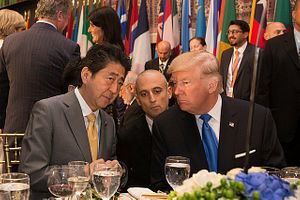In theory, Japan remains the United States’ staunchest ally in East Asia. The ties have ostensibly been bolstered by a strong personal connection between the leaders of the two countries, cemented by their shared love of golf. But with Prime Minister Shinzo Abe returning to Tokyo after two days in Mar-a-Lago with little to show for his continued efforts to woo U.S. President Donald J. Trump, there is a great deal of talk about what happens next. Amid mounting concerns about Tokyo being marginalized in talks with North Korea on the one hand and worries about U.S. trade strategy on the other, Japan is at a critical juncture in assessing how the United States fits into its own strategy of furthering its own economic and security interests as the regional dynamics rapidly evolve.
The fact that the much-ballyhooed friendship between Abe and Trump has not led to any concrete results has undoubtedly been a tremendous blow for the Japanese premier at a time when he is facing mounting political pressure at home, from scandals over cronyism to sexual harassment scandals involving some of his senior people. Still, Abe going home empty-handed after his latest meeting with Trump is a setback for Japan, and not just for the prime minister. In fact, the 15 months since the president took office have been a tumultuous period for Abe, who is quickly losing ground not just on the domestic front, but on the global stage as well.
So long as Abe seemed to enjoy solid relations with the White House, the position of the world’s third-largest economic power was seemingly solid, in both political and economic terms. The reluctance of the U.S. under Trump to assume its mantle as an Asian power was undoubtedly an opportunity for Tokyo to champion some of the values that had been hallmarks of U.S. commitment in the region, most notably adherence to the rule of law and ensuring open markets. Meanwhile, as the Trump administration quickly decided to withdraw from the Trans-Pacific Partnership, it was Tokyo that played a key role in ensuring that the remaining 11 TPP member countries would continue to move forward and get to an agreement for the Comprehensive and Progressive Trans Pacific Partnership deal, which was completed in March. Japan has been consistent in encouraging the United States to rejoin the TPP, and Trump’s comments that he might well reconsider going back have been welcomed. Given that Trump’s latest musing about the possibility of rejoining came only days before his meeting with Abe, there was a great deal of anticipation about the possibility, which would undoubtedly have given Abe’s regional leadership credentials a boost.
Instead, Abe has found himself being told very publicly that the United States remains committed to pursuing bilateral trade agreements instead of multilaterals, with a side note that the U.S. trade deficit with Japan remained a major problem. It seems increasingly likely that Washington will step up efforts to reach a bilateral free trade agreement with Japan, which would undoubtedly pressure Tokyo to give further concessions on key industries including the critical automobile sector.
In the nearer term, though, Abe’s prime concern is his inability to get Japan into the group of seven countries that have been temporarily exempted from the steel and aluminum tariffs. Rather than joining the likes of Australia, South Korea, the European Union, Canada, and Mexico, Japan has effectively been placed in the same category as China, with section 232 tariffs imposed on Japanese steel and aluminum exports on the grounds of national security concerns. While the decision is a blow to Japanese steelmakers, the political implications have been even larger, as confidence about how Tokyo is perceived by the current administration and its commitment to broader relations between the two countries on the security as much as the economic fronts have been rattled.
Amid such wariness about what actions the United States might take against Japan on the trade front, Tokyo has been expanding its outreach within Asia. It has been a driving force in pushing for an Indo-Pacific strategy to corral like-minded nations including the United States across the Asia-Pacific to collaborate on ensuring free and open markets as well as commitment to the rule of law. The more notable development, however, is without doubt a growing willingness between Tokyo and Beijing to identify common objectives. Certainly, the economic dialogue that was held in Tokyo days before the latest Trump-Abe meeting in Florida was groundbreaking, not least because it was the first time in eight years that the foreign ministers of China and Japan were able to engage in a constructive discussion, including talks about advancing the Regional Comprehensive Economic Partnership trade agreement and the possibility of bringing South Korea to the table for trilateral economic talks. As Beijing and Tokyo discuss the possibility of a summit meeting between their leaders, the fact that the two countries have put aside their many source of friction, most notably over territories in the East China Sea, to address areas for potential cooperation is a path that may become ever more attractive as tensions with the United States rise.
For now, though, Abe’s biggest concern will be his own political survival. With little to show from his latest meeting with Trump, his gambit to deliver a win on the diplomatic front may well have backfired.
Shihoko Goto is the Senior Associate for Northeast Asia with the Woodrow Wilson Center’s Asia Program based in Washington DC.
































